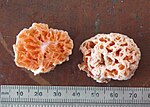Cystidia is a genus of moths in the family Geometridae. Cystidia couaggaria Guenée, 1857 Cystidia indrasana (Moore, [1866]) Cystidia stratonice (Stoll...
994 bytes (45 words) - 20:16, 5 July 2023
some cells develop into sterile cells called cystidia (basidiomycetes) or paraphyses (ascomycetes). Cystidia are often important for microscopic identification...
3 KB (295 words) - 18:53, 8 June 2024
paraphyses. Similar structures called cystidia often occur within the hymenium of the Basidiomycota. Many types of cystidia exist, and assessing their presence...
47 KB (4,978 words) - 12:23, 21 May 2024
has a whitish pileus and lageniform cystidia. Melanoleuca excissa (Fr.) Singer with urticoid and septate cystidia, often with crystals at the apex. Melanoleuca...
18 KB (1,766 words) - 08:32, 16 May 2024
spores, but with a slightly tapered base, and measure 21–29 by 5–8.4 μm. Cystidia are cells of the fertile hymenium that do not produce spores. These sterile...
38 KB (3,914 words) - 10:32, 18 May 2024
brown. The pleurocystidia (cystidia on the gill face) measures 30–38 x 5–10 μm, hyaline, fusoid to subventricose. The cystidia on the gill edge (cheilocystidia)...
5 KB (522 words) - 11:34, 24 January 2024
bowling-pin-shaped cystidia, on conidia, basidiospore germ tubes, and mycelium that adhere to and capture nematodes. The fruitbodies bear thick-walled cystidia (metuloids)...
5 KB (283 words) - 16:54, 22 December 2022
lemon shaped, basidia 4 spored. Gill edge cystidia fusiform, typically with long necks, gill face cystidia absent. Panaeolus fimicola can be found growing...
5 KB (384 words) - 19:12, 15 January 2024
Psilocybe caerulipes by microscopic characteristics such as the presence of cystidia on the gill faces (pleurocystidia), and cheilocystidia (found on the gill...
8 KB (1,012 words) - 19:21, 9 April 2024
thin or slightly thick-walled. There are no cystidia on the gill face (pleurocystidia). Pileocystidia (cystidia on the surface of the cap) are club-shaped...
13 KB (1,485 words) - 16:27, 10 January 2024
thick-walled cystidia in the hymenium, and narrow, sausage-shaped (allantoid) spores. The specific epithet amylocystis refers to the amyloid cystidia, and hints...
1 KB (130 words) - 22:05, 16 January 2024
release. Cystidia that are located along the edge of the cap (called cheilocystidia) are spherical, and 30–120 by 20–74 μm. The facial cystidia (called...
42 KB (4,553 words) - 18:58, 14 June 2024
clustered node roots of this plant are covered in hairs called cystidium. The cystidia found on these roots allow easy attachment to fungi hyphae, such as can...
13 KB (1,293 words) - 17:40, 25 May 2024
coloured by sulphovanillin or other reagents. The specialized cells termed cystidia can also be gloeoplerous. Hyphae might be categorized as 'vegetative' or...
15 KB (1,573 words) - 02:54, 14 May 2024
measure 7–10 μm × 4–6 μm; they are smooth, elliptical, and inamyloid. Cystidia absent. Pileipellis without broom cells. Marasmius oreades is a choice...
6 KB (673 words) - 00:51, 29 May 2024
setae". In mycology, "setae" refer to dark brown, thick-walled, thorn-like cystidia found in corticioid and poroid fungi in the family Hymenochaetaceae. Though...
11 KB (1,250 words) - 14:18, 15 January 2024
the locules comprise erect cystidia mixed with chains of erect cylindrical hyphae measuring 4–6 μm in diameter. The cystidia are roughly cylindrical, and...
10 KB (1,119 words) - 00:18, 14 February 2024
27–37 by 9–11 μm. Clamp connections are present in hyphae. Cheilocystidia (cystidia on the gill edge) are abundant. They are hyaline (translucent), thin-walled...
16 KB (1,558 words) - 18:58, 9 April 2024
rarely has an incurved margin. The gills are attached and usually have cystidia. Some species, like Mycena haematopus, exude a latex when the stem is broken...
18 KB (1,500 words) - 23:46, 10 March 2024
group bluing species with hyaline pleurocystidia (clear or transparent cystidia on the gill face), and thick-walled, sub-ellipsoid spores measuring up...
15 KB (1,636 words) - 11:37, 25 May 2024
cheilocystidia (cystidia on the gill edge) that are covered with one or more, knob-like, apical protuberances, the absence of pleurocystidia (cystidia on the gill...
8 KB (965 words) - 21:15, 16 May 2024
skeletal hyphae in the context, sclerotium and the stipe. The hymenium lacks cystidia. Spores are smooth, ellipsoid, hyaline, and inamyloid. Lignosus is similar...
5 KB (427 words) - 17:43, 23 May 2024
hyaline (translucent), and measure 14–22 by 8–10 μm. The cheilocystidia (cystidia on the gill face) measure 16–22 by 4–9 μm, and are lageniform (flask-shaped)...
16 KB (1,742 words) - 19:17, 9 April 2024
pore, and have a plage. Many species also have characteristic tibiiform cystidia. However, there are many exceptions, and many species of Galerina lack...
16 KB (1,660 words) - 22:50, 8 March 2024
veil, and the occasional presence of caulocystidia (cystidia on the stem), pileocystidia (cystidia on the cap surface), or dark setae-like elements. Several...
17 KB (1,659 words) - 17:48, 10 January 2024
subgenus), smooth, never verrucous and germ-free. Basidia are tetrasporic. Cystidia with or without crystalline crystals, spindle-shaped, convex in the middle...
16 KB (1,612 words) - 01:28, 29 May 2024
distinguished from other species in the genus by its dark colouration and distinct cystidia. There are some populations that seem to prefer deciduous trees and others...
29 KB (2,907 words) - 21:11, 3 June 2024
later by Guzman and Watling and called the type, with distinctive brown cystidia, is missing from Cleland's collections in Adelaide. A formal lectotype...
13 KB (1,217 words) - 13:53, 12 June 2024
ranges, and by differences in the morphology of microscopic structures like cystidia. The species was first mentioned by French mycologist Roger Heim in 1956...
29 KB (3,081 words) - 21:08, 13 January 2024


























